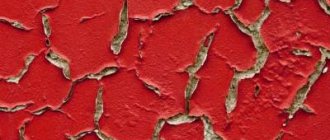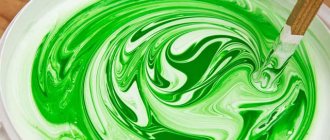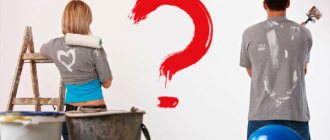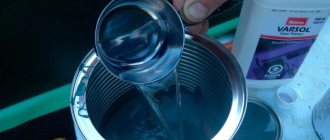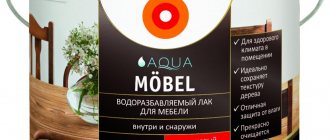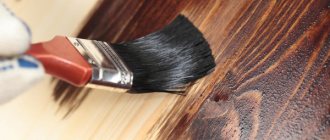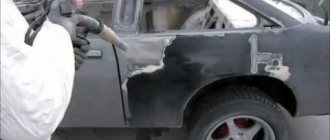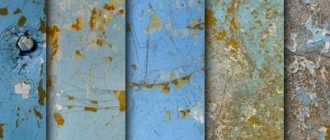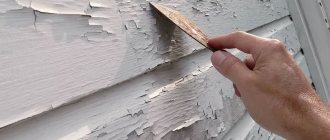Due to its liquid consistency, the composition is quickly absorbed into the upper layers, and if not removed in time, it penetrates even deeper. Dried mixture is more difficult to remove.
How and what to use to remove paint stains from concrete, carpet, bathtubs and other surfaces? This is discussed in the article.
Top 10 universal recipes for use at home
The main rule for removing any paint is to remove it immediately. This will save time, nerves, the product or surface being cleaned.
There is no need to rub the stain in different directions - clean from the edge to the middle . If the blot is large, it is first soaked with a dry cloth or rag. Any selected product is tested on an inconspicuous area.
How to remove a stain with butter or vegetable oil?
Mix any of them with washing powder and rub into the dirt. Leave for 30 minutes, pour dish soap onto the stain and wash the item.
The oil is also suitable for removing paint and varnish materials from the skin of the face and body.
It is better not to use it on concrete, wooden and metal surfaces, as greasy marks may remain.
How to remove with vinegar and soda?
Suitable for removing water-soluble coatings, including old stains from them from clothes. Moisten the area with water, add baking soda, and treat with a brush dipped in vinegar. Leave for 2-3 hours, wash the item.
You can even wipe off dried paint from other surfaces with baking soda, but only if it is a small and shallow stain. The product is also suitable for skin.
If you use vinegar, it must be diluted with water to avoid burns.
Water, soap, washing powder
Used to clean water-based paint from any surface. If it is clothing, the stain is washed with water, then soaped, after 1-2 days it is washed in a machine or by hand .
The blot is wiped off the surfaces first with a dry cloth and then with a napkin soaked in a soapy solution.
How to remove with acetone?
Acetone works well even on old traces of paint. This method is easy to use and does not take much time.
The instructions are simple:
- moisten a napkin in acetone;
- rub the surface until the paint comes off.
If there is a lot of paint, then try to change the napkin as often as possible.
Nail polish remover
Suitable for removing solvent-based coatings from almost any surface. It may not work on large and old stains. Rub the stain with a cotton pad soaked in liquid.
Alcohol
Suitable for removing fresh paint and varnish materials from any surface . It may not be able to handle large stains. Soak a cloth in alcohol and rub the stain until completely clean.
White spirit, gasoline, kerosene
They act similarly to acetone. Use with caution on delicate surfaces. They work on old paint, but are not suitable for removing large areas.
How to remove with turpentine?
It perfectly removes paint and varnish from various surfaces, but before use it is tested on an inconspicuous area.
A mixture of turpentine and ammonia (1:2) is used as a remover of old paint. Effective 20 minutes after application.
The disadvantage of the product is a strong, difficult-to-remove odor.
Chalk, caustic soda, lime dough
The composition is used as a folk remedy for removing old paintwork. The action begins after about 1 hour.
Ammonia
Removes water-soluble dye stains almost 100% . The mixture for removing paint stains is prepared as follows: 30 g of salt, 65 ml of 9% vinegar and 50 ml of ammonia (ammonia).
Next, the prepared composition is distributed over the dirt, after 10 minutes it is treated with a toothbrush or cloth.
After treatment, the item is rinsed in water and washed.
Chemical methods
Since compositions intended to soften paint are chemically aggressive, food and indoor plants should be removed from the room where the treatment is being carried out. The windows open wide. For work, you should prepare a respirator and protective clothing.
- A liter of solution is enough to clean the walls in a small bathroom. To process the kitchen you will need a little more.
- When purchasing a remover, pay attention to the composition. It is more convenient to use a universal one, designed for processing concrete, brick, wood or metal.
- The solution is applied to the wall for 2 hours. Next, the softened paint is removed with any sharp instrument - a spatula or scraper.
A serious disadvantage of such means is aggressiveness. Contact with mucous membranes or skin is unacceptable to avoid burns. After treatment, the room will need to be thoroughly ventilated - the smell from them is quite persistent. Regardless of the composition, all types of chemical removers are prohibited from being flushed down the drain.
You can also prepare the wash yourself. For a glass (250 ml) of ammonia you will need 2 kg of chalk. This paste is diluted with a liter of water and applied to the wall for a couple of hours.
Special means
Special products facilitate the removal of paintwork materials and minimize the risk of damage to the tissue or any surface.
They are produced in the form:
- liquids,
- gel,
- spray,
- pasta.
The principle of action of removers is approximately the same - after their application, paint and varnish materials swell and crack. Then they are removed with a spatula, scraper or special devices.
Antikras
One of these removers is Anti-Kras, a universal liquid product for removing paint on any basis from various surfaces: wood, metal, plastic, concrete.
The line also includes products labeled:
- Sprint is a super fast action for metal.
- Facade – for cleaning facades.
- P – for removing powder paint from metal.
Antikras is a domestic product.
The average cost for 1 kg is about 400 rubles. The larger the container, the cheaper. Available in containers of 1, 5 and 25 kg. Consumption per 1 sq. m. – up to 0.25 ml. The method of application is described above. After application, the remover begins to act within 3-15 minutes . Upon completion of work, wash the cleaned surface with soapy water or an organic solvent.
ABRO PR-600-R
A popular representative of aerosol removers is the American-made ABRO PR-600-R spray. The price for a 400 ml can is on average 350 rubles. It is also a universal remedy. The only thing is that before using it on plastic, you need to conduct a test in an inconspicuous area.
Mode of application:
- Prepare the surface.
- Keep the cylinder vertical.
- Spray from a distance of about 25 cm.
- Wait for the reaction (up to 20 minutes).
- Remove paintwork mechanically.
If necessary, the process is repeated. Next, the surface is simply rinsed with water.
Prestige gel
Universal gel-like remover of domestic production. The price for a 800 g jar of Prestige starts at 200 rubles . The principle of operation is similar to other washes. Consumption up to 150 g per 1 sq. m. Wash off with water.
The above products are suitable for external and internal work . Most washes have a strong odor and are unsafe for the skin of your hands. Therefore, be sure to wear gloves and, if possible, a respirator. The room should be well ventilated.
Cleaning the wall from mold
You need to get rid of mold in the most radical way. If mold appears on the wallpaper, it will have to be completely removed and the wall surface thoroughly dried. Using a spatula, remove mold to the very base of the wall and apply an antiseptic primer to the cleaned wall.
Advice. Regular table vinegar works well against mold. It is applied to mold-infected areas and washed off after an hour. For prevention purposes, repeat the procedure several times. Also effective in the fight against mold is baking soda, an aqueous solution of which is sprayed onto surfaces. And ammonia mixed with water will get rid of mold no worse than a store-bought antiseptic.
How can you remove different types of dyes?
The process of removing any paintwork material depends on the composition, age, area of application, and the painted material.
For hair and eyebrows
If we talk about the skin, the best cleansers are:
- vegetable oil,
- rich face cream,
- nail polish remover.
Rub the area with a cotton pad soaked in one of the substances.
To rinse hair, use fat-based products (kefir, mayonnaise, oil), honey, soda. Liquid substances are rubbed into clean, damp hair, left for 20 minutes to 3 hours, then washed off. Soda (1 tbsp) is diluted with shampoo, then washed.
Remove the substance from clothes using laundry soap, peroxide or vinegar. First, the problem area is washed with cool water, then soaped, and washed after 20 minutes. If this does not help, treat the stain with peroxide or vinegar.
Read more about hair dye removal here. This article will tell you how to remove eyebrow dye from the skin, and from the eyebrows, if you don’t like the result, this publication will tell you.
Watercolor, gouache
A fresh stain can be easily removed if you immediately wash the item with soap or powder . If the watercolor has dried, it is cleaned off, the area is washed under running water and soaped, the item is put into cellophane and left for 20-30 minutes.
In case of severe contamination, the procedure is done at night. Then wash the product by hand or in a machine. Read more here.
Acrylic
If the blot is fresh, it is first scraped off the surface with something. If it is fabric, the area is washed under running hot water. Then they soap the stain and rub it well. The procedure is repeated until the paint disappears. We must act quickly.
If the mixture is dry, do this:
- WITH
soak the stain with cold water. - Apply a solvent: ammonia, acetone, purified gasoline, white spirit or denatured alcohol. If you don't have any on hand, nail polish remover will do.
- Rub thoroughly with a sponge or soft toothbrush.
- They wash it.
- Rinse in clean water.
Read about ways to remove acrylic paint from linoleum here, and from clothes - here.
Alkyd and oil enamels
Such paints and varnishes are removed from clothing and various surfaces with solvents, but only on condition that they are fresh. Using a moistened rag, use sharp movements to collect the blot from the edge to the middle so as not to rub it.
Old stains can also be cleaned with acetone, gasoline, white spirit, but if they are small and applied in a thin layer (strokes, drops). The enamel is carefully scraped off the glass with a blade. Traces are removed with solvents.
If we talk about very old alkyd and oil coatings on large areas (walls, doors, windows, floors), then they are removed:
- mechanically: with a spatula, sandpaper, grinding machine;
- under the influence of high temperature: heat with a blowtorch or a hair dryer, and then clean off;
- using special softening removers (the easiest way).
Read about removing enamel from clothes here. Read about how to remove oil paint from various surfaces here.
Stamp
There are several ways to remove the composition from clothing:
Mustard. Make a paste from dry powder, apply it thickly to a fresh stain and leave for a day.- Turpentine and ammonia (for dried paint). The substances are mixed in equal quantities. The solution is poured onto the stain and held until the paint completely disappears. Next, the item is washed and rinsed.
- Glycerin with denatured alcohol . Used to clean leather products. Heated glycerin is mixed with denatured alcohol. The composition is rubbed into the problem area.
These same options can be tried on various surfaces.
Water-emulsion and water-dispersion
These paints and varnishes are easily washed off with plain clean water. Provided the stains are fresh. If the emulsion or dispersion has dried, it can be easily cleaned mechanically: rub the hard surface with a sponge or brush, or scrape it with a sharp non-metallic object. Wash off traces with water.
There is an easier way: thoroughly moisten the blots with water. So to remove them you will need a minimum of effort; they can be easily washed with a regular wet cloth.
Fresh emulsion and dispersion are washed off from clothes without problems. The dried mixture is first rubbed off with a cloth, and then the product is washed in the usual way.
Latex
Traces of latex from clothing are removed using hairspray . Spray the product onto the stain and rub it with something until it disappears. Then wash with the addition of stain remover.
Printer toner
If dry cartridge refill powder gets on your clothing or any surface, do not immediately use water.
First, the toner is wiped off with a dry rag . Then the area is washed with cold water. The remaining stains are removed with any alcohol-containing product: acetone, alcohol, ammonia.
If we talk about things, then marks are soaped on them, left for half an hour, and then washed with the addition of bleach or stain remover. The dirty surface is wiped with detergent.
If printer ink gets on your clothes, it is also better not to wash it off immediately with water . The blot is soaked with a dry cloth, and only then washed under running water. Then they act as in the case of dry toner, including when ink gets on any surface.
Read about removing toner from your hands here.
Aerosol
The choice of cleaning agent depends on the composition of the spray paint. Many of them, while fresh, can be easily washed off the fabric and removed from the surface with a soap solution.
In other cases, heavy artillery is used - solvents. The stain is treated with the selected product until it disappears completely.
What to consider when choosing a paint removal method
There are no universal ways to quickly clean walls of old coatings. Before starting work, it is recommended to choose a method that will require minimal effort and time.
It is recommended to pay attention to the following points:
- decide how much money will be required to purchase tools and whether such costs are justified;
- how long does it take to clean off the old coating from the wall;
- type of base (wood, brick, concrete, etc.);
- type of paint (oil, acrylic, enamel);
- number of layers of coating (sometimes it is more difficult to peel off a thin layer).
Black, white and color
As such, there are no differences in the removal of black, white or colored paintwork materials. Regardless of the base, stains of the same tone may remain due to the pigment added to the composition.
Some dyes are easily washed off, others are firmly ingrained . In any case, the paint is rubbed off carefully so as not to rub it even more.
If it gets on clothes, then clean the problem area before washing. It is not advisable to crumple the item so that other areas do not become saturated. The stain is washed under running water or a napkin is placed under it during treatment.
What is the best way to remove paint from the floor?
The easiest way to remove floor coverings is with a belt sander. In this case, belts with a coarse grain (for example, P40) are used first, and then paper for primary sanding (P100, P120). More details in the abrasive materials category.
After cleaning, before applying a new coating, be sure to putty the gaps between the boards.
Unsafe way
Often they try to remove paint from the floor with an electric plane, but this should not be done. It can only be used at the final stages of cleaning to reveal the texture of the wood. This is done if you plan to varnish the floor in the future.
If you still need to plan wood, then the Dnipro-M electric planer is ideal for this purpose.
The nuances of cleaning different surfaces
If we talk about minor stains from paints and varnishes on clothes or surfaces, in most cases they can be easily removed with ordinary soap or washing powder. Old stains are treated with solvents.
| Name | Water based | On solvents | Silicate | Hair and eyebrow dye |
| Concrete | Due to the porous structure, it is better to use a brush to wash | It is advisable to use a remover, since mechanical cleaning risks damaging the surface. | Wash | Wipe with any solvent |
| Carpet, clothes, jeans, jacket | Fresh stains are cleaned well; the pigment can be absorbed into the material; stain removers recommended | Remove with solvents | Vinegar solution or ammonia | Stain removers, solvents |
| Pipes, bath, batteries | Easy to clean with a damp brush | Small stains are treated with solvents, and to remove the coating - with a remover. | No data | Damp cloth or solvent |
| Wood (windows, doors, floors) | Wash well with plain water and a stiff sponge or brush. | It is advisable to use a remover, since mechanical cleaning risks damaging the surface. | No data | Damp cloth or solvent |
| Metal, glass | Mechanical cleaning is not recommended; soft brush or hard sponge | Wash | No data | Wet sponge, solvent |
| Ceiling, walls | Wash well with plain water and a stiff sponge or brush. | Wash | Wash | Depending on the type of surface, it is preferable to remove fresh paint with a dry cloth |
| Plastic | Easy to clean with a damp brush | Products suitable for removing paintwork from plastic | No data | Damp cloth or solvent |
| Skin of face and hands, hair | Wash with usual means: soap, shampoo; dry paint is cleaned with pumice stone or a sponge | It is difficult to remove due to the toxicity of solvents, it is better to wait, after a week the paint will come off on its own; in advanced cases, you can carefully treat problem areas with acetone, but in such a way as to minimize its contact with the skin | Vinegar solution | From the skin - with vegetable oil, from the hair - with a special wash |
| Linoleum | Easy to clean with a damp brush | Minor stains are treated with solvents | Vinegar solution or ammonia | Wet sponge, solvent |
You can learn about removing paint from bathroom walls in this article.
When should you remove old paint and why?
More often, repairs require removal of oil-based paint, and sometimes water-based paint. This need does not always arise; it depends on the type of finish chosen.
You can leave the old paintwork in the following cases:
- The walls will be finished with plasterboard.
- Lining or wall panels are used as finishing.
- When repainting, when the coating is durable, there are no chips, bubbles or cracks. Sometimes you will have to remove peeling areas by filling the base with finishing putty. This method is not suitable if water-based or acrylic paint is applied over old oil paint.
Before applying wet plaster to the walls or gluing wallpaper, the old coating should be removed, since the absorbency of the painted wall is minimal, the composition will not be able to linger on a smooth surface.
More often you have to remove paint:
- oil;
- water-based;
- water-dispersed.
Tools and materials, as well as the method, should be selected taking into account the type of old coating.
With the mechanical removal method, you can use both hand tools and power tools with special attachments.
How to quickly get rid of the smell?
The smell comes mainly from the solvents in the composition. They are absorbed into the surface and last a very long time.
How to get rid of odor:
- Ventilate the room.
- Wash surfaces with vinegar, soda or saline solution.
- Hang wet sheets indoors.
- Place dishes with absorbents.
- Spray air freshener.
If the house has air conditioning, then the task becomes easier. An ionizer and dry fog also help.
Features of removing coating from wood
It’s worth noting right away that pressed wood is difficult to clean. As with drywall, if the paint holds up well, paint over it.
Solid wood cleans well. Various methods and materials can be used. If you want to remove paint from wood, such as wooden windows, as quickly as possible, use a power tool. The truth is that only a flat surface can be cleaned well. The paint from the gaps will have to be removed manually.
Uneven wood is easiest to clean using the thermal method. Using a hair dryer, you can clean doors, window frames, and even carvings and furniture.
There is another way to remove old paint from wood. To do this, make a paste mixture of chalk, lime and soda. Chalk and lime are taken in a 1:1 ratio, after which soda diluted in water is added. The mixture is applied to the surface and left for 2 hours. The paint softens and is removed. Afterwards the surface is washed with water and vinegar. After such a wash, the result is quite effective.
Tips and prohibitions
A few recommendations for those who clean up dirt on their own:
- Methods and means are chosen so as not to damage the product or surface.
- It is advisable to work with the use of protective equipment: glasses, rubber gloves, respirator. Especially if the volume is large, toxic and substances with a pungent odor are used.
- Don’t skimp on special tools: they significantly speed up the process.
The use of improvised means is justified for minor contaminations. When cleaning large areas (windows, doors, walls, metal) from old paintwork materials, this is only a waste of nerves and time.
Removing water-based paint
Most of these compositions are easily softened with ordinary water. It is more convenient to treat the surface with a roller. After 10-15 minutes, wet paint can be easily removed with a spatula or wire brush. If it does not come off in one go, the wall should be soaked and scraped again. To prevent the moisture from evaporating, treat one small area at a time, and then move on to the next.
Moisture-resistant water-based compounds are more difficult to remove using this method. If the paint does not get wet, you will have to arm yourself with a drill or grinder.
So, there are several ways to remove old paint. Which one to use is up to you. Small areas are easier to handle with an ax or hammer and chisel. To remove it from large surfaces, it is better to use a drill, grinder or a special tool.
